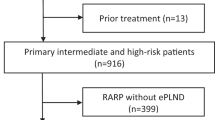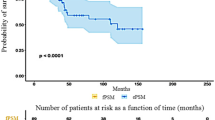Abstract
Objectives
The prognostic value of free to total PSA ratio (F/T PSA) in patients eligible for radical prostatectomy (RP) is controversial. The aim of the present study was to evaluate correlation of F/T PSA with tumor extracapsular extension (ECE) and biochemical recurrence (BR) at long-term follow-up.
Patient and methods
Clinical and pathological data were prospectively gathered from 200 patients treated with RP for clinically localized prostate cancer (PCa) and PSA between 4 and 10 ng/mL. Correlations of preoperative variables including F/T PSA with ECE and BR were evaluated with uni- and multivariate analysis. Adjunctive analyses evaluated the association of PSA F/T with other pathological results. The relationship between preoperative F/T PSA and BR was also assessed with Kaplan–Meier survival analysis.
Results
Lower F/T PSA was significantly correlated with ECE (p = 0.0063), higher GS (p = 0.0054), and seminal vesicles involvement (p = 0.0047). The F/T PSA value of 14% provided the greatest discrimination in predicting ECE. At multivariate analysis, F/T PSA did not achieve the statistical significance for predicting ECE independently. At a mean (median, range) follow-up of 52 (48, 14–116) months, preoperative F/T PSA resulted significantly correlated with BR (p = 0.001). At the Kaplan–Meier survival analysis, the 5-year BR free survival rate resulted 89.3 and 68.9% in the group with F/T PSA >14 and ≤14 ng/mL, respectively (log rank p = 0.0022). At Cox proportional hazard model, only ECE resulted an independent predictor of BR (R = 2.646, p = 0.037).
Conclusion
In patients with clinically localized PCa and PSA 4–10 ng/ml, lower F/T PSA was significantly associated with ECE, other adverse pathologic features, and with BR at the long-term follow-up, but only ECE resulted an independent predictor of BR in our series.

Similar content being viewed by others
References
Catalona WJ, Partin AW, Slawin KM, Brawer MK, Flanigan RC, Patel A, Richie JP, deKernion JB, Walsh PC, Scardino PT, Lange PH, Subong EN, Parson RE, Gasior GH, Loveland KG, Southwick PC (1998) Use of the percentage of free prostate-specific antigen to enhance differentiation of prostate cancer from benign prostatic disease: a prospective multicenter clinical trial. JAMA 279(19):1542–1547
Elgamal AA, Cornillie FJ, Van Poppel HP, Van de Voorde WM, McCabe R, Baert LV (1996) Free-to-total prostate specific antigen ratio as a single test for detection of significant stage T1c prostate cancer. J Urol 156(3):1042–7; discussion 1047-9
Aus G, Becker C, Lilja H, Khatami A, Pihl CG, Hugosson J (2003) Free-to-total prostate-specific antigen ratio as a predictor of non-organ-confined prostate cancer (stage pT3). Scand J Urol Nephrol 37(6):466–470
Southwick PC, Catalona WJ, Partin AW, Slawin KM, Brawer MK, Flanigan RC, Patel A, Richie JP, Walsh PC, Scardino PT, Lange PH, Gasior GH, Parson RE, Loveland KG (1999) Prediction of post-radical prostatectomy pathological outcome for stage T1c prostate cancer with percent free prostate specific antigen: a prospective multicenter clinical trial. J Urol 162(4):1346–1351
Morote J, Encabo G, de Torres IM (2000) Use of percent free prostate-specific antigen as a predictor of the pathological features of clinically localized prostate cancer. Eur Urol 38(2):225–229
Graefen M, Karakiewicz PI, Cagiannos I, Hammerer PG, Haese A, Palisaar J, Huland E, Scardino PT, Kattan MW, Huland H (2002) Percent free prostate specific antigen is not an independent predictor of organ confinement or prostate specific antigen recurrence in unscreened patients with localized prostate cancer treated with radical prostatectomy. J Urol 167(3):1306–1309
Shariat SF, Abdel-Aziz KF, Roehrborn CG, Lotan Y (2006) Pre-operative percent free PSA predicts clinical outcomes in patients treated with radical prostatectomy with total PSA levels below 10 ng/ml. Eur Urol 49(2):293–302. Epub 2005 Dec 20
Bangma CH, Kranse R, Blijenberg BG, Schröder FH (1997) The free-to-total serum prostate specific antigen ratio for staging prostate carcinoma. J Urol 157(2):544–547
Partin AW, Mangold LA, Lamm DM, Walsh PC, Epstein JI, Pearson JD (2001) Contemporary update of prostate cancer staging nomograms (Partin Tables) for the new millennium. Urology 58(6):843–848
Mufarrij P, Sankin A, Godoy G, Lepor H (2010) Pathologic outcomes of candidates for active surveillance undergoing radical prostatectomy. Urology 76(3):689–692
Kane CJ, Im R, Amling CL, Presti JC Jr, Aronson WJ, Terris MK, Freedland SJ, SEARCH Database Study Group (2010) Outcomes after radical prostatectomy among men who are candidates for active surveillance: results from the SEARCH database. Urology 76(3):695–700
Carini M, Masieri L, Minervini A, Lapini A, Serni S (2008) Oncological and functional results of antegrade radical retropubic prostatectomy for the treatment of clinically localised prostate cancer. Eur Urol 53(3):554–61. Epub 2007 Jul 16
Haese A, Graefen M, Steuber T, Becker C, Pettersson K, Piironen T, Noldus J, Huland H, Lilja H (2001) Human glandular kallikrein 2 levels in serum for discrimination of pathologically organ-confined from locally-advanced prostate cancer in total PSA-levels below 10 ng/ml. Prostate 49(2):101–109
Shariat SF, Roehrborn CG, McConnell JD, Park S, Alam N, Wheeler TM, Slawin KM (2007) Association of the circulating levels of the urokinase system of plasminogen activation with the presence of prostate cancer and invasion, progression, and metastasis. J Clin Oncol 25(4):349–355
Leman ES, Cannon GW, Trock BJ, Sokoll LJ, Chan DW, Mangold L, Partin AW, Getzenberg RH (2007) EPCA-2: a highly specific serum marker for prostate cancer. Urology 69(4):714–720
Steuber T, O’Brien MF, Lilja H (2008) Serum markers for prostate cancer: a rational approach to the literature. Eur Urol 54(1):31–40. Epub 2008 Jan 22. Review
Arcangeli CG, Humphrey PA, Smith DS, Harmon TJ, Shepherd DL, Keetch DW, Catalona WJ (1998) Percentage of free serum prostate-specific antigen as a predictor of pathologic features of prostate cancer in a screening population. Urology 51(4):558–64; discussion 564–5
Noldus J, Graefen M, Huland E, Busch C, Hammerer P, Huland H (1998) The value of the ratio of free-to-total prostate specific antigen for staging purposes in previously untreated prostate cancer. J Urol 159(6):2004–7; discussion 2007-8
Lerner SE, Jacobsen SJ, Lilja H, Bergstralh EJ, Ransom J, Klee GG, Piironen T, Blute ML, Lieber MM, Zincke H, Pettersson K, Peterson D, Oesterling JE (1996) Free, complexed, and total serum prostate-specific antigen concentrations and their proportions in predicting stage, grade, and deoxyribonucleic acid ploidy in patients with adenocarcinoma of the prostate. Urology 48(2):240–248
Pannek J, Rittenhouse HG, Chan DW, Epstein JI, Walsh PC, Partin AW (1998) The use of percent free prostate specific antigen for staging clinically localized prostate cancer. J Urol. 159(4):1238–42 (Review)
Author information
Authors and Affiliations
Corresponding authors
Rights and permissions
About this article
Cite this article
Masieri, L., Minervini, A., Vittori, G. et al. The role of free to total PSA ratio in prediction of extracapsular tumor extension and biochemical recurrence after radical prostatectomy in patients with PSA between 4 and 10 ng/ml. Int Urol Nephrol 44, 1031–1038 (2012). https://doi.org/10.1007/s11255-012-0135-y
Received:
Accepted:
Published:
Issue Date:
DOI: https://doi.org/10.1007/s11255-012-0135-y




